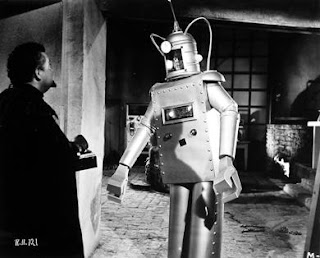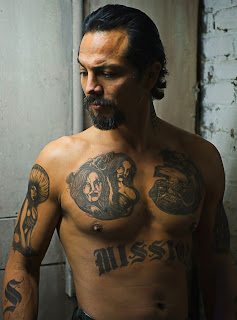I caught several films at various venues in the past month.
My favorite was
OSS 117 - Lost in Rio that I saw at the
Lumiere. The French spoof on James Bond and the 1960's hit several of the right notes including tremendously inspiring wardrobe by stars Jean Dujardin and Louise Monot. Those swinging cats in the 60's knew how to dress. With homage to Sean Connery,
North by Northwest and
Harper,
OSS 117 (117 as opposed to 007) looked like a 1960's film down to the film stock. The plot is just a vehicle for Dujardin to bumble his way aroung Brazil as Hubert Bonisseur de la Bath, France's greatest spy which is roughly akin having the best sushi restaurant in Outer Mongolia. Casually racist, self-absorbed and sexist, de la Bath tangles with some Nazis in exile (boys from Brazil) and their Lucha Libre henchmen. He is ably and patiently assisted by Israeli Mossad agent Dolorès Koulechov (Monot). Although not nearly as silly as
Austin Power,
Lost in Rio elicited several laughs and smiles from me. Among my favorite scenes were the climax on the Christ the Redeemer statue, the opening dance sequence, de la Bath's dabbling with LSD and group sex and the "masquerade party" where de la Bath was dressed as Robin Hood, Dolorès as a sexy French maid and everyone else in SS uniforms.
§§§
I drove down to Palo Alto to catch
High Noon and
Stagecoach at the
Stanford Theater.
I've seen
High Noon many times but never in a theater. I can't recall the last time I saw the film but will say that I recall the theme song playing a larger part during the film as a leitmotif. The use of the song was not nearly as prevalent or obvious as I recalled. I also noticed that Stanley Kramer's production company produced the film. Katy Jurado was more beautiful and her character more dignified than I remembered. Gary Cooper was still wooden and Lloyd Bridges was still a punk. The roles of the three gunman waiting for Frank Miller was less significant than I recall. I thought Lee Van Cleef got more screen time.
I watched
Dark Waters at the recent Roxie Noir series. The heavy in that film was played by Thomas Mitchell. At first, I though it was Charles Laughton as Mitchell seemed to be imitating his speech. Before
Dark Water, I could not have identified Thomas Mitchell by name or appearance.
By coincidence, Thomas Mitchell played the mayor in
High Noon and the drunken doctor in
Stagecoach. In
Stagecoach, it seemed the role was patterned on W.C. Fields and Mitchell's performance was styled after Fields' performances opposite Mae West.
I've never seen
Stagecoach in its entirety in one sitting. In fact, I can say now that I had not seen
Stagecoach it its entirety over multiple viewing. I have seen parts of the film many times on television but there were scenes that were new to me when I watched it last weekend at the Stanford.
Stagecoach was famous for making John Wayne a star and director John Ford's first hit film (in talkies). The film looks cliche now but I can overlook. Looking at the performances, I was that impressed with the Duke. Andy Devine as the nervous, high-pitched stagecoach driver, Berton Churchill as the insufferable embezzler and Thomas Mitchell as the drunken doctor drew more attention for their over-the-top performances. John Carradine as the Southern gentleman/gambler and Claire Trevor as the prostitute clinging to her last strand of self-respect gave quiter and more affecting performance. John Wayne...well, he went through the film like mailman delivering his letters: it wasn't too exciting, he made a few mistake but ultimately he got the job done. Chris-Pin Martin made the most of a small role as a way station manager with an Apache wife.
The best parts of the film were not the action scenes (which were rather sparse) but the social conflicts between the passengers. What a motley bunch - escaped convict (John Wayne), drunken doctor (Mitchell), gambler (Carradine), whore (Trevor), meek alcohol salesman, blustering banker (Berton Churchill) and pregnant wife (who didn't look pregnant to me). The banker, the wife, and the gambler (with the manners of a Southern gentleman) look down on the outlaw, the whore and the drunkard.
There was also an interesting epilogue where John Wayne's character confronts three brothers in Lordsburg. The main brother is described as a stone-cold killer that would cut down the Ringo Kid (Wayne) but when news of the Kid's arrival reaches him and his brothers, they seem petrified. I'm guess they devalued Ringo's enemies to make it more realistic (it was 3 on 1 afterall). It also highlighted the courage of Ringo by contrast.
§§§
I finally saw a general release film -
Kick-Ass at the AMC 1000 on Van Ness Ave. The building the theater is in used to be a Cadillac dealership. It's multi-story and
Kick-Ass was playing on the top floor. I think I must have gone up four or five flights of escalators. Although it has 14 screens, it doesn't look like any multiplex I've been in.
Much has been written about
Kick-Ass. I saw it nearly 3 months after it was released. I enjoyed it. I'm not so big on action films. The gunfight and hand-to-hand sequences looked cartoonish which may been the intent. It was interesting how they sprinkled anxiety inducing moments of violence among the action scenes. Two scenes that made me cringe was when they were torturing a mobster and they had his pinky finger in between the blades of a lock cutter and when they put another mobster in an industrial size microwave oven (used for desiccating lumber).
The film is really melds various genres into one - teen sex comedy, revenge tale and comic book action story. Also there were many tremendous performances - Nicholas Cage was a bit stiff as always but he got a lot of mileage out his Adam West inspired speech cadence. Chloë Moretz as his profanity spewing, ass kicking daughter had the flashiest role and made the most of it. Christopher Mintz-Plasse also showed some range and skills as the son of a mob boss who assumes a superhero alterego to lure out the titular character.
§§§
I went to see
The Red Machine at the
Red Vic. The directors and star were in attendance. The film was very low-budget and it showed in the wardrobe and acting but overall I was impressed and entertained. The plot could have used another round of polishing to clear up a few matters. In a nutshell, the US Navy recruit a safecracker out of prison to steal a top secret code/cypher machine from a Japanese naval attaché (the film is set in the 1935). Technically, they can't steal it because if it is missing, the Japanese will change they cryptology. They have to dismantle it to figure out how it works and reassemble it without the Japanese knowing. Then for good measure, they steal the codebooks.
The two men assigned to the job are genial safecracker who feels he isn't living up to his potential as a criminal and a stone-faced naval officer who was infamously disgraced (for reasons never quite revealed) and has a history with the Japanese officer and his wife. They are an odd couple but eventually grow to like and admire each other. I won't give away the ending because it was contrived.
The major plot hole I couldn't reconcile is why these two men were assigned this crucially important job. Everyone's performance seemed a little flat. Lee Perkins who played the uptight naval officer could have gotten away with the performance because it was consistent with the character. Towards the end, he has an emotional scene where he recounts his failed love affair and Perkins couldn't find the right emotional tenor.
However, a small film like
The Red Machine deserves to be graded on the curve.
The Red Machine was preceded by a short film called
Gandhi at the Bat (2006). It was a cute faux newsreel about Mohandas Gandhi visiting a Yankees-Phillies game in the 1930's. The Mahatma gets to bat and the results are suitably (and expectedly) amazing. The two leads from
The Red Machine appear in
Gandhi at the Bat. If nothing else,
Gandhi at the Bat is worthwhile for its closing credit soundtrack - a catchy rendition of
Take Me Out To the Ballgame played on Indian musical instruments.
§§§
OSS 117 - Lost in Rio starring Jean Dujardin and Louise Monot; French with subtitles; (2009) -
Official WebsiteHigh Noon starring Gary Cooper and Grace Kelly; (1952)
Stagecoach starring John Wayne & Claire Trevor; directed by John Ford; (1939)
Kick-Ass starring Aaron Johnson & Christopher Mintz-Plasse; with Nicholas Cage; (2010) -
Official WebsiteThe Red Machine starring Lee Perkins and Donal Thoms-Cappello; (2009) -
Official Website





